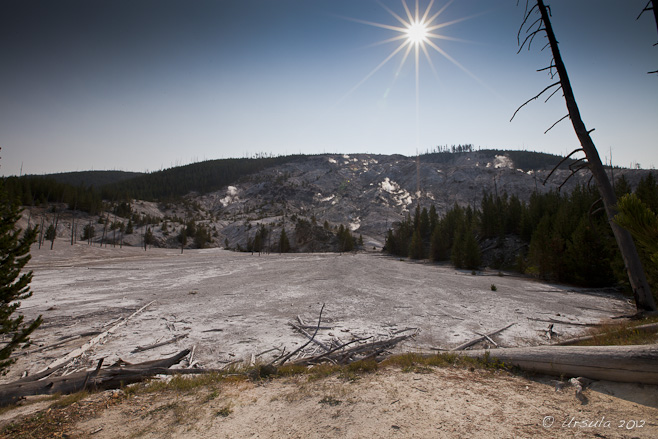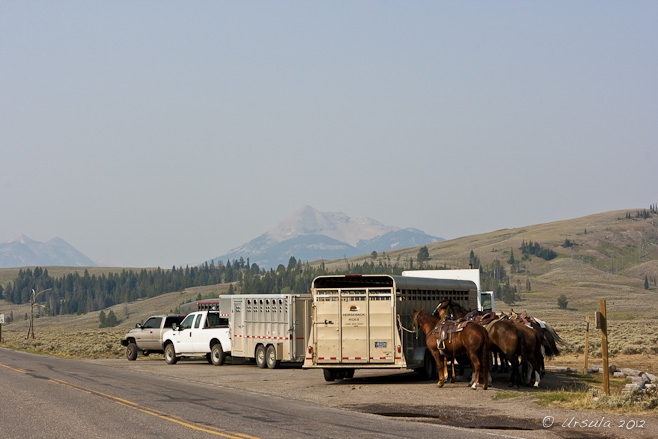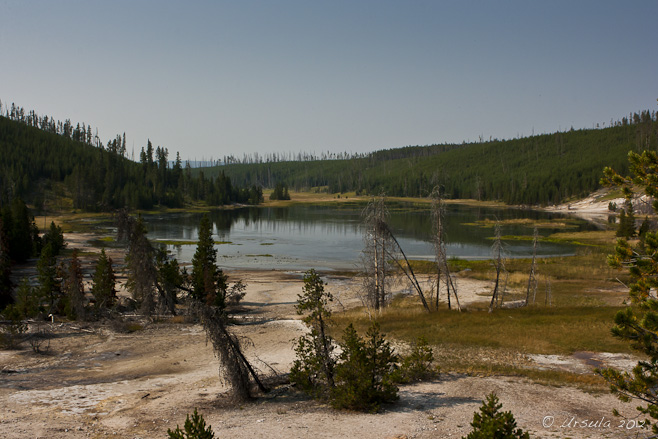
Morning sunshine over Roaring Mountain, Yellowstone National Park.
How many parks can claim UNESCO World Heritage status?
Yellowstone National Park, the world’s oldest “National Park”, established in 1872 by an act of American congress, has been a designated World Heritage site since 1978. Home to more geothermic activity than anywhere else on earth, Yellowstone is also one of the last, nearly intact, temperate-zone ecosystems, providing a refuge and natural home for many plants and animals that no longer thrive elsewhere.
UNESCO also recognises Yellowstone for its “extraordinary scenic treasures”; an assessment I’d have to agree with. While we loved seeing Old Faithful and some of the other iconic Yellowstone National Park activity, it was equally impressive to see just how much else the park has to offer.

The horses wait for their morning riders: Yellowstone Plateau.
I had vague childhood memories of the Paint Pots at Kootenay National Park in British Colombia, and so was curious to see Yellowstone’s Artist’s Paint Pots. This is one of the less-visited attractions in the park, but we enjoyed the short walk (1.8 km) along the trail and boardwalk that takes you around pretty geothermic hot springs, mudpots, fumarole, and a small geyser.

Small lake, Artist’s Paint Pots, Yellowstone National Park

A bubbling hot spring ~ one of the many fascinating, but nameless, features at the Artist’s Paint Pots.

Subtle colours and beauty ~ Artist’s Paint Pots Yellowstone

Steam rises everywhere from hot springs and from cracks and fissures in the earth.

It amazes me how many plants survive and thrive at the edges of the geothermal pools.

Some of the small springs bubbled with amazing enthusiasm!

Impossibly clear springs contrast with red and white soils and green grasses.

New-growth lodgepole pines grow next to the steaming hot pools.

Nature’s Still Life: This area suffered major forest fire in 1988, and the evidence is still around.

Some of the “paint pots” are brightly coloured by cyanidia, a unicellular red algae.

The milky-blue colour in some of the features comes from silica, suspended in the water.

Visitors try to capture the white-on-white.

The boiling white mud in the Paint Pots is a clay mineral called kaolinite.

There is a constant “plopping” noise as the clay in the mud pots builds up heat and bubbles over.

Another silica milky-blue pond.

Beside the trail back to the car park, autumn Fringed Gentians (Gentionopsis crinito) signal the onset of cooler weather.
 It was a delightful stop, and a good introduction to some of the natural beauty the park has to offer.
It was a delightful stop, and a good introduction to some of the natural beauty the park has to offer.
Until next time ~ Happy Rambling!
Pictures: 13August2012





















.png)

